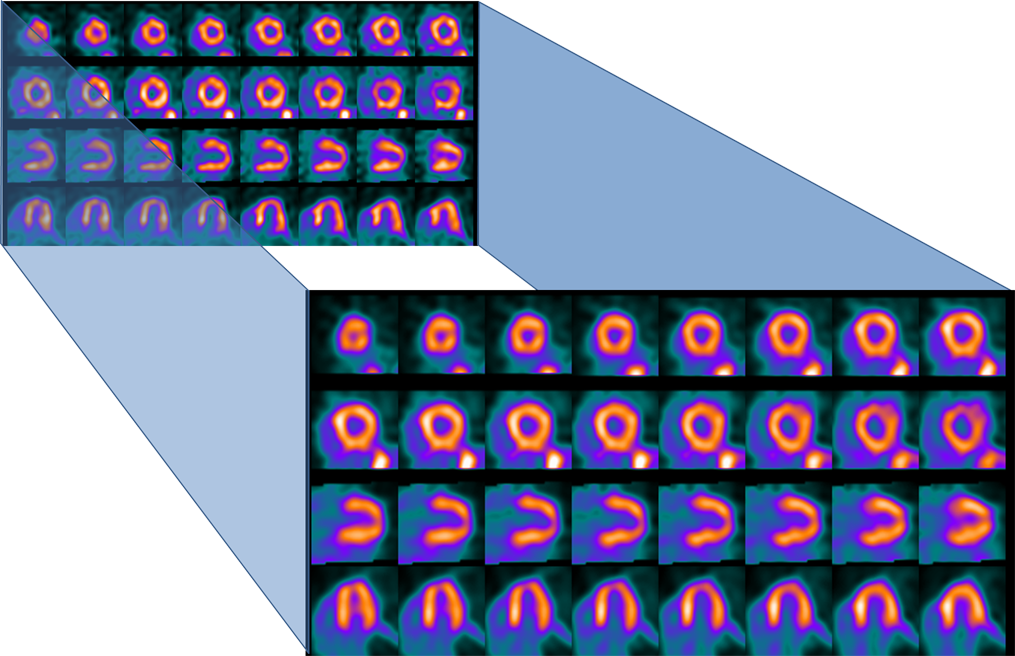Imagen3D 2.2 Making 3D PET a Reality
Imagen3D™ works in conjunction with ImagenPRO® as an additional processing step 3D PET (septa retracted mode) data. Utilizing a Monte Carlo simulation, data is automatically corrected for scatter and prompt gamma photons. It then is seamlessly exported to the ImagenPRO® program for processing. Imagen3D™ improves the image quality of 3D PET even at the lowest recommended dosages.

Imagen3D 2.2
“We recently successfully converted from 2D to Imagen3D™ for our laboratory. Imagen3D™ has become a cornerstone of our program to improve our cardiac PET image quality. Imagen3D™ has allowed us to minimize radiation exposure and image the largest patients throughout the generator cycle without sacrificing image quality. This has reduced our wait time and improved laboratory efficiency in addition to the lower radiation exposure.”
- Gary V. Heller, M.D.
- President
- Heller Healthcare Group
- Hartford, CT

Imagen3D™ Features
- Monte-Carlo Simulation: Imagen3D™ uses a state of the art fast Monte Carlo simulation to estimate the contribution of scatter and prompt gamma events to the raw data (1). The 3D PET result is a final image that correlates with traditional 2D imaging both in image quality and quantitative information (2).
- Prompt Gamma Correction: Thirteen percent of all Rb-82 decay events create a third “prompt gamma” photon. Many 3D PET algorithms do not account for this additional photon, introducing severe image artifacts. (3). Imagen3D™ provides prompt gamma correction for Rb-82 imaging, achieving the benefits of 3D imaging without sacrificing image quality.
- Improving Image Quality with More Counts: PET imaging in 3D allows more true counts to get to the detector. To take advantage of the increased number of true events, Imagen3D™ accounts for all of the scatter, prompt gamma and random events that can introduce iamge artifacts. (1).
- Imagen3D™ Allows for Greater Flexibility: Imaging cardiac PET in 3D is considerably more challenging than imaging in 2D. Lower dosages, higher scatter fractions, and prompt gamma photons, all degrade image quality. Image3D™ allows users to leverage the power of 3D PET imaging, without sacrificing image quality.
- Imagen3D™ Enables Absolute Quantitation for Most Dedicated Cardiac PET Systems: Imagen3D™ opens the door for absolute imaging for most non-listmode PET imaging systems.
- Case, J. et al., 2003. IEEE Nuclear Science Symposium Conference Record.
- Case, J. et al. 2012. Circulation 126:A16597.
- Esteves, F. et al. 2010. Journal of Nuclear Cardiology 17(2):247-255.
Minimum PC specifications
- Intel Pentium M 2.4 GHz, 64-bit processor (4+ cores, i7 3.0Ghz or better preferred).
- Minimum 8 Gb system memory (16 Gb preferred).
- Requires a CUDA capable, NVDIA Corporation graphics card with a minimum of 1024 GPU cores.
- Two network cards will provide increased flexibility for network configuration.
- Windows 10 Professional.
- 1Tb of hard disk space (preferred).
- Mouse, and US English keyboard.
Warning!!!!
Federal law restricts this device to sale, distribution and use by or on the order of a physician and other practitioners licensed by the law of the State in which the device is used. Specific training in the use of this device is required.